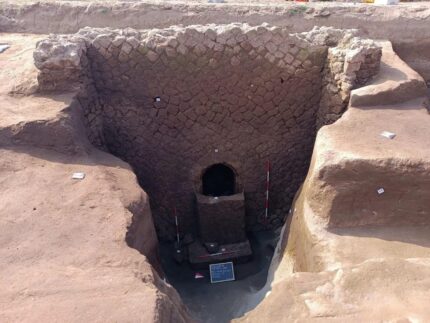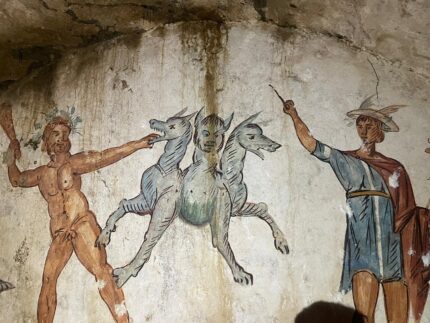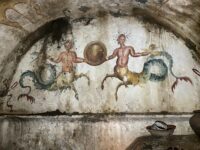Water works in Giugliano, a suburb of Naples, has uncovered an untouched chamber tomb with frescoed ceilings and walls in pristine condition. The frescoes of mythological figures and swags are on all four walls of the tomb. They are perfectly intact and still maintain their brilliant color. Preliminary estimates date the tomb to around 2,000 years ago.
 The tomb was found on farmland as part of an archaeological survey at the site of updates to the water supply system. A test excavation revealed the presence of numerous ancient burials, inhumation and cremation, covering at least 400 years from the Republican era to the Imperial eta. At the edge of the necropolis, archaeologists found an opus incertum (masonry style using different shapes and sizes of uncut stone) wall. It proved to be front wall of a chamber tomb and like the interior, it too was in outstanding condition, still sealed with a heavy tufa slab over the square entrance. The top of the tomb was notched to create an opening that was blocked with tiles once all the work and funerary rituals were complete.
The tomb was found on farmland as part of an archaeological survey at the site of updates to the water supply system. A test excavation revealed the presence of numerous ancient burials, inhumation and cremation, covering at least 400 years from the Republican era to the Imperial eta. At the edge of the necropolis, archaeologists found an opus incertum (masonry style using different shapes and sizes of uncut stone) wall. It proved to be front wall of a chamber tomb and like the interior, it too was in outstanding condition, still sealed with a heavy tufa slab over the square entrance. The top of the tomb was notched to create an opening that was blocked with tiles once all the work and funerary rituals were complete.
 Archaeologists accessed the chamber tomb by removing the tiles covering the ceiling opening. They found the contents completely untouched and in pristine condition. The walls are painted with swags and mythological scenes. The striking painting that has given the tomb its monicker depicts the 12th and most dangerous of the Labors of Hercules: when he descended to Hades guided by Mercury to capture the three-headed monster dog Cerberus. The front wall features the Ichthyocentaurs, a pair of sea gods with the upper bodies of men, forelegs of a horse and long, serpentine tails of a fish, hold a clypeus (a round shield) between them. They are attended by two winged erotes (Roman Cupid-like babies).
Archaeologists accessed the chamber tomb by removing the tiles covering the ceiling opening. They found the contents completely untouched and in pristine condition. The walls are painted with swags and mythological scenes. The striking painting that has given the tomb its monicker depicts the 12th and most dangerous of the Labors of Hercules: when he descended to Hades guided by Mercury to capture the three-headed monster dog Cerberus. The front wall features the Ichthyocentaurs, a pair of sea gods with the upper bodies of men, forelegs of a horse and long, serpentine tails of a fish, hold a clypeus (a round shield) between them. They are attended by two winged erotes (Roman Cupid-like babies).
 Inside the tomb were also three painted klinai (altars) holding vessels used to pour libations, and even more remarkably, the deceased themselves, placed on funeral beds alongside rich grave goods. The excavation of the chamber tomb is ongoing, and archaeologists plan to investigate the larger necropolis as well.
Inside the tomb were also three painted klinai (altars) holding vessels used to pour libations, and even more remarkably, the deceased themselves, placed on funeral beds alongside rich grave goods. The excavation of the chamber tomb is ongoing, and archaeologists plan to investigate the larger necropolis as well.
* This article was originally published here









No comments:
Post a Comment